List of Contents
Passwordless Authentication Market Size and Forecast 2025 to 2034
The global passwordless authentication market size was accounted at USD 19.14 billion in 2024 and is anticipated to reach around USD 82.50 billion by 2034, growing at a CAGR of 15.73% from 2025 to 2034. The passwordless authentication market growth is attributed to the increasing need for secure, seamless authentication solutions.
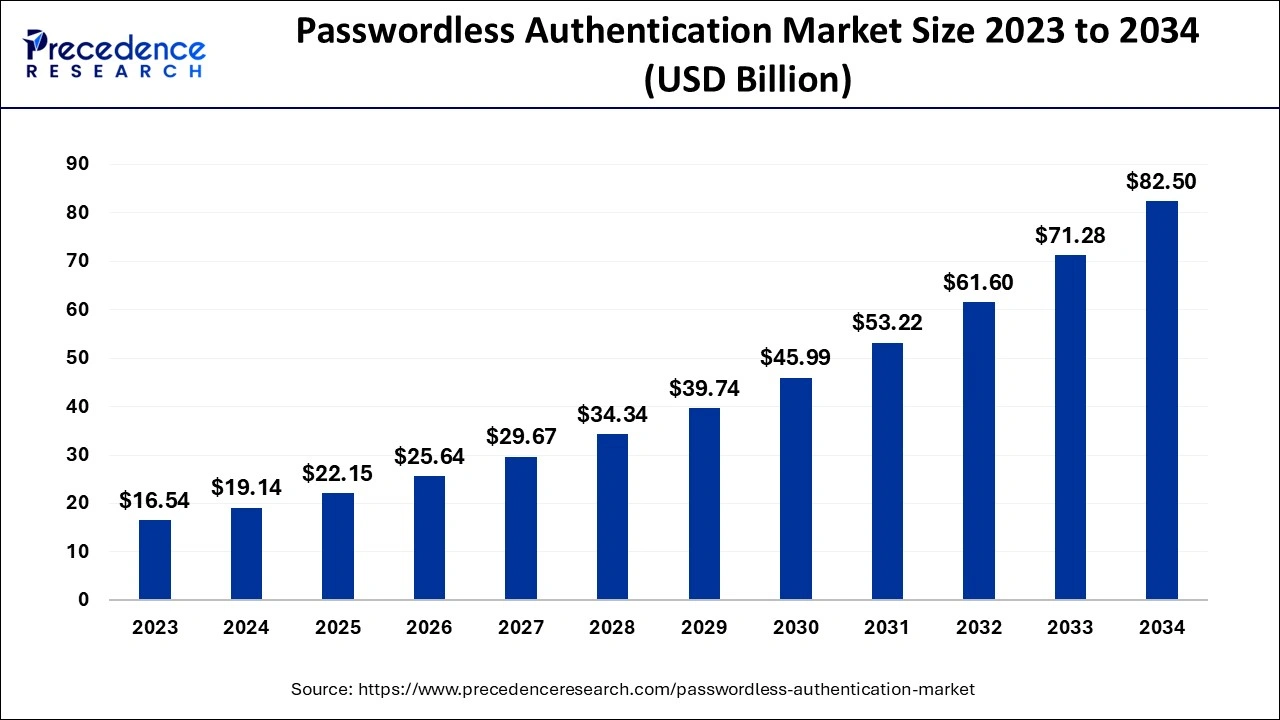
Passwordless Authentication Market Key Takeaways
- The global passwordless authentication market was valued at USD 19.14 billion in 2024.
- It is projected to reach USD 82.50 billion by 2034.
- The passwordless authentication market is expected to grow at a CAGR of 15.73% from 2025 to 2034.
- North America dominated the global market with the largest market share of 40% in 2024.
- Asia Pacific is anticipated to witness the fastest growth during the forecasted years.
- By type, the fingerprint or thumbprint authentication segment contributed the highest market share in 2024.
- By type, the authentication using face recognition segment is expected to grow at the fastest CAGR during the forecast period.
- By authentication type, the multi-factor segment captured the biggest market share in 2024.
- By authentication type, the single factor segment is anticipated to grow with the highest CAGR from 2025 to 2034.
- By industry vertical, in 2024, the BFSI segment led the global market.
- By industry vertical, the healthcare segment is projected to expand rapidly during the forecast period.
Impact of Artificial Intelligence (AI) on the Passwordless Authentication Market
Artificial intelligence fuels the advancements in the passwordless authentication market that secure access technologies are experiencing by advocating for biometric authentication, behavioral analysis, and risk-adaptive security. AI allows systems to efficiently process large amounts of data instantaneously and detect anomalous login patterns, or threats to security. This improves the strength of the authentication techniques while minimizing the use of passwords. Moreover, AI identity authentication is expected to prove key as businesses seek to strengthen cybersecurity, thus extending the use of sophisticated security structures with coping issues such as theft of credentials and identity fraud.
U.S. Passwordless Authentication Market Size and Growth 2025 to 2034
The U.S. passwordless authentication market size was evaluated at USD 5.36 billion in 2024 and is projected to be worth around USD 23.56 billion by 2034, growing at a CAGR of 15.96% from 2025 to 2034.
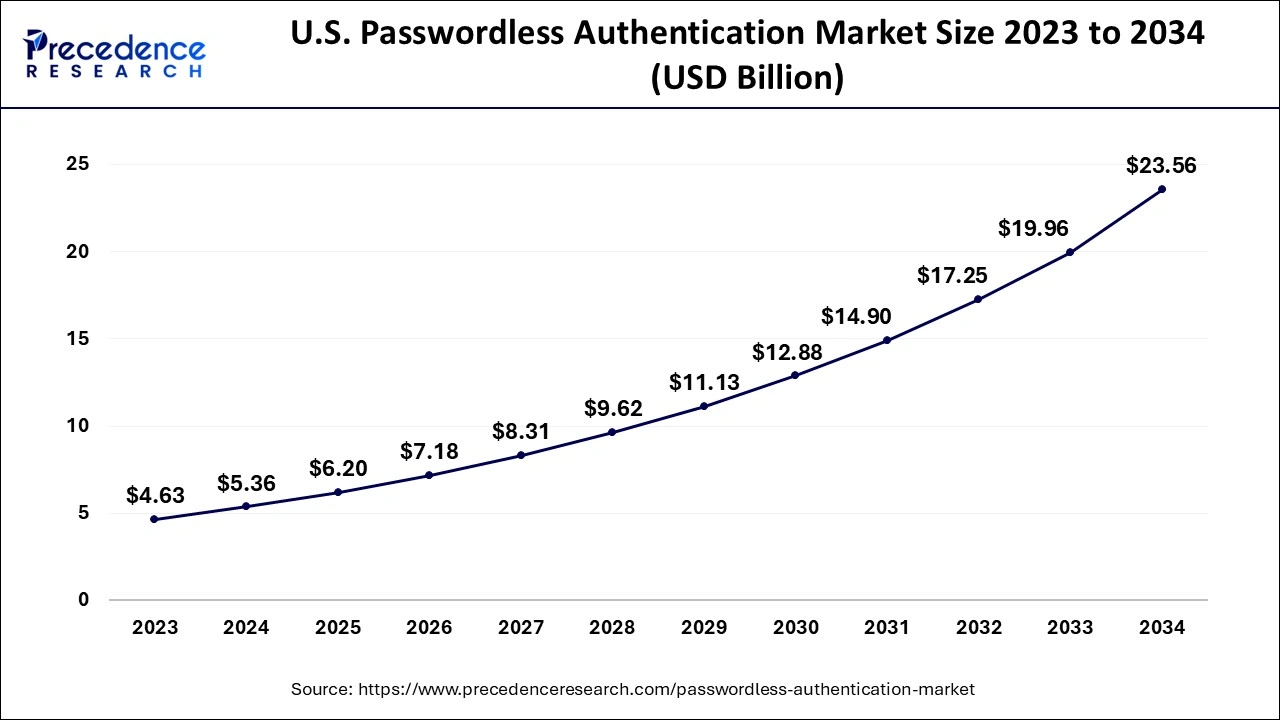
North America dominated the global passwordless authentication market in 2024, due to the rising security threats, and the wider uptake of hi-tech means of accreditation in the region. Especially in the U.S., where businesses are already spending significantly on passwordless authentications and other security solutions against the growing cyber threat. Moreover, the growth of passwordless authentication is also backed by the government; programs such as the National Institute of Standards and Technology (NIST) Cybersecurity Framework further fuel the market in this region.
- The average weekly cyberattacks in this region have risen by 52%, according to statistics from STATIONX LTD, a leading cybersecurity solutions provider.
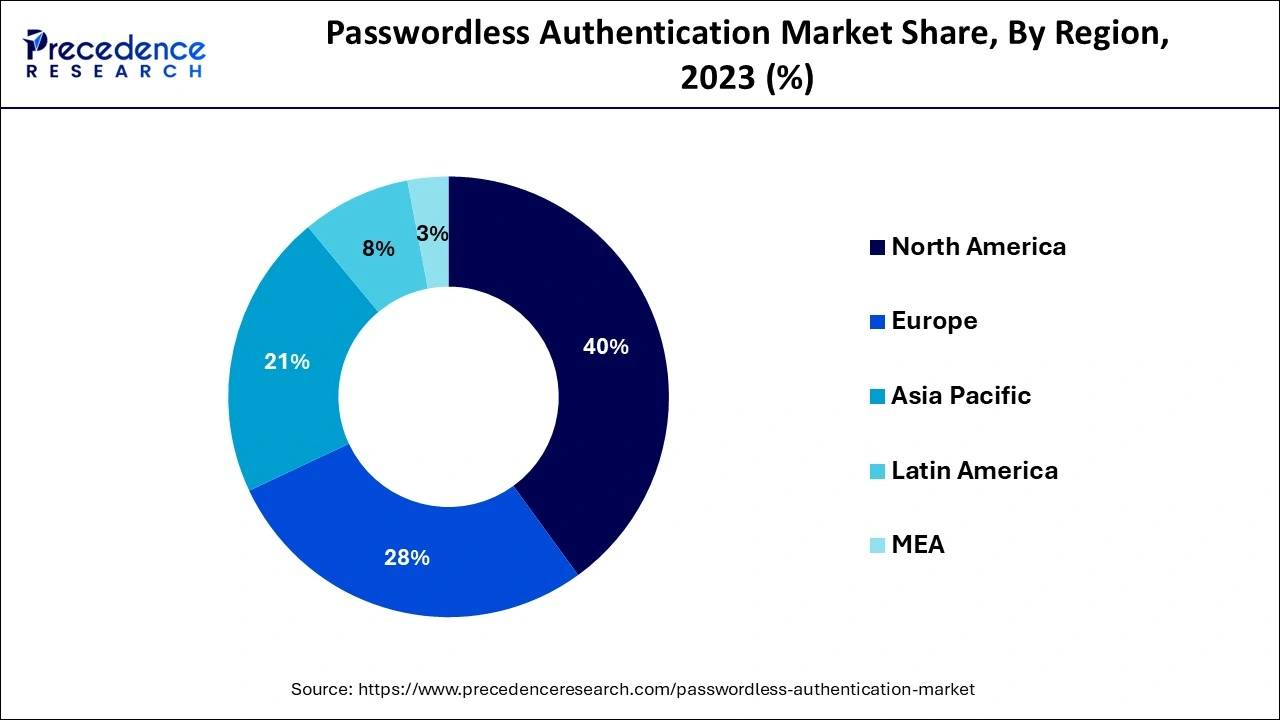
Asia Pacific is projected to host the fastest-growing passwordless authentication market in the coming years, owing to the rise in investments in cybersecurity leading to the adoption of passwordless solutions. China, India, and Japan as the countries that are ready to invest in advanced authentication technologies, as the increasing digitalization and the high level of cyber threats. The popularity of e-commerce, mobile payments, and cloud applications in the region has increased the need for trusted authentication solutions. Furthermore, the emergence in governmental and corporate consciousness of reliably secure solutions especially in highly endangered areas is likely to boost this growth.
Market Overview
Passwordless authentication which is a security method based on particular standards, including FIDO (Fast Identity Online) is gradually recognized as vital in the field of cyber security, especially in the context of the most widespread and dangerous threat. This shift has grown greatly due to the weaknesses brought about by the use of passwords and matters arising from the use of passwords which include password reuse on various platforms. The passwordless authentication market solutions, such as biometrics or hardware keys are purposely built to withstand phishing attacks and deliver more secure meaningful interactions.
Passwordless Authentication Market Growth Factors
- Increasing cybersecurity threats: The rise in cyberattacks, especially phishing and credential stuffing, is driving demand for more secure authentication methods.
- Rising adoption of biometric technology: The growing acceptance of biometric systems like fingerprint and facial recognition is fueling the demand for the passwordless authentication market.
- Supportive government regulations: Strict regulations and standards, such as GDPR and NIST guidelines, are compelling organizations to adopt more secure authentication measures.
- Surge in digital transformation: Companies rapidly adopting digital platforms require secure and efficient authentication solutions, boosting the market for passwordless authentication.
- Cloud adoption: The growing reliance on cloud-based systems has increased the need for seamless and secure authentication solutions.
- Improved user experience: Passwordless authentication provides a smoother user experience, contributing to its widespread adoption across industries.
- Growth of mobile payments: The increasing use of mobile devices for financial transactions is driving the need for secure, passwordless authentication methods in the financial sector.
Market Scope
| Report Coverage | Details |
| Market Size by 2034 | USD 82.50 Billion |
| Market Size in 2024 | USD 19.14 Billion |
| Market Size in 2025 | USD 22.15 Billion |
| Market Growth Rate from 2025 to 2034 | CAGR of 15.73% |
| Largest Market | North America |
| Base Year | 2024 |
| Forecast Period | 2025 to 2034 |
| Segments Covered | Type, Authentication Type, Industry Vertical, and Regions |
| Regions Covered | North America, Europe, Asia-Pacific, Latin America, and Middle East & Africa |
Market Dynamics
Driver
Increasing demand for enhanced cybersecurity measures
Increasing demand for enhanced cybersecurity measures is projected to drive the adoption of the passwordless authentication market solutions. The ISC2's 2024 study showed that organizations with skills shortages in cybersecurity faced nearly double the possibility of sustaining a data breach emphasizing the sophisticated need for proficient solutions. Methods, such as voice recognition, fingerprint scanning, and other passwordless authentication are safe and do not take as much time as conventional methods. These solutions help fix the issues outlined by the growing incidence of phishing attacks and credential theft. Furthermore, this trend is only accelerated by industries such as finance, healthcare, and IT which are experiencing the shift towards digital transformation as companies demand the scalability of solutions to ensure that their operations remain secure.
- In 2023, the FBI alone received over 880,418 cybercrime complaints with losses of over USD 12.5 billion, underlining the serious risks of traditional password-based systems.
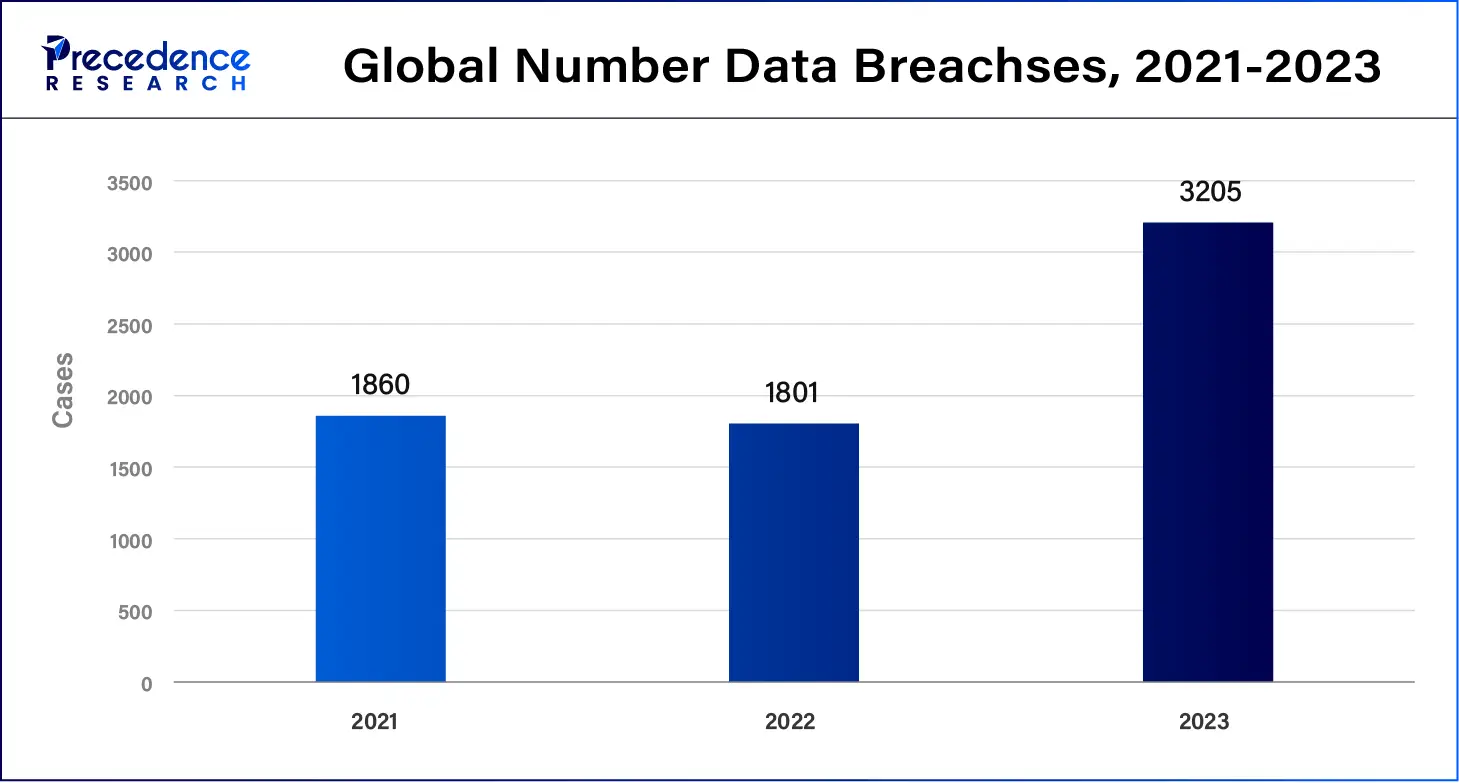
Restraint
Implementation due to high initial costs
High initial costs of implementing the passwordless authentication market solutions are expected to restrain market adoption, particularly for small and medium-sized enterprises (SMEs). The use of technologies, such as biometrics, multifactor authentication, and hardware security modules attract heavy infrastructure commitment and employee education. However, due to resource constraints, many organizations especially those relatively new in the field have not been able to finance the upgrade to these advanced authentication systems. This financial burden becomes challenging in areas with meager IT budgets or a developing IT environment since cost continues to be an issue. These constraints keep passwordless systems from being implemented more often despite the long-term advantage they provide to systems.
Opportunity
High investment in secure authentication solutions
High investment in the passwordless authentication market is projected to propel the development and implementation of next-generation access technologies. Worldwide corporations emphasize superior security systems to combat impending threats. Organizations stepped up for the technologies such as biometric and AI-based authentication solutions. Likewise, the World Economic Forum stated in 2023 that accurate AI-driven authentication technologies are necessary to push back against increasingly complex cyber threats and support governments and enterprises. These frameworks require stringent access control to protect such information, leading to a strong tendency to invest in high-cost solutions such as passwordless authentication. Furthermore, behavioral biometrics and continuous authentication keep drawing funding for the development of modern non-intrusive security solutions for enterprises.
- A report by Secureframe, a prominent provider in cybersecurity, reveals that the average cost of a data breach hit a record high in 2024, reaching USD 4.88 million. This marks a 10% increase compared to 2023.
Component Insights
The software/platform segment held the largest share of 49.60% in the 2024 global passwordless authentication market. The software platform is an epicenter of the global passwordless authentication industry. The platform refers to the infrastructure of the market that provides numerous passwordless methods, such as hardware keys, mobile authenticators, and biometrics. The segment is bolstering development by deploying standards like FIDO2/WebAuthn. The identity and access management (IAM) platforms are essential to this market, acting as a central control point for integration of several passwordless methods, managing identities, and enforcing policies. Organizations rely on this platform for convenient and safe access.
The passwordless login platforms and behavioral biometrics software have achieved significance in the software platform segment. The mobile authentication apps enable easy access, push notifications, and biometrics. Innovation is thriving in the passwordless authentication sector to create a friendly digital environment. The authentication of API and SDKs is a major component for controlling access to resources and protecting applications from suspicious events.
The services segment is expected to grow at a CAGR of 18.40% during the forecast period. The services segment is consistently developing with its rapid improvement in security and user experience with services such as security keys, push notifications, and biometrics. The professional services feature consulting, security assessments, and implementation and integration services, enabling seamless and quick guidance or access to large organizations with massive data. The managed services enable expertise to maintain, support, and execute global passwordless authentication solutions globally, without troubling the in-house IT teams and dealing with the complicated task on their own, such as system integration, ongoing security monitoring, user support, and vendor selection.
Authentication type/ technology Insights
The biometric authentication segment held the largest share of 32.70% in the 2024 global passwordless authentication market. The biometric authentication includes facial recognition, iris/retina scan, voice, and fingerprint recognition. The segment is accelerating at a speed, with most of the individuals and companies having preferred and adopted this authentication as advanced technology in their respective sectors. The biometric access into the big companies for attendance review of the employee in their system has made the monitoring easy with the right calculation of the time.
The behavioural biometrics segment is expected to grow at a CAGR of 19.30% during the forecast period. The behavioural biometrics is an AI-driven approach involving mouse movement, navigation habits, and typing patterns. The segment consistently authenticates users by cracking complex patterns such as mouse movement and typing rhythm, serving adaptive and passive security for passwordless authentication.
Authentication channel Insights
The mobile app-based segment held the largest share of 37.40% in the 2024 global passwordless authentication market. The mobile app-based authentication helps to navigate the security status from anywhere and has access to stop or lock if any fraud is detected. The segment is increasingly expanding in work and modern home systems. The organization builds applications that provide access to mark attendance and secure data according to the departments under the IT team's supervision. The modern high-tech home systems have adopted authenticators to protect their personal space from theft and criminals. Overall, the mobile-app-based authentication is strengthening the infrastructure of the organization sector and protecting the personal environment.
The multi-channel (omnichannel platforms) segment is expected to grow at a CAGR of 18.80% during the forecast period. The omnichannel platform is fundamental for global passwordless authentication. It enables secure, seamless, and consistent user experience throughout every essential point, such as websites, call centers, and mobile apps. The segment could lead under the fastest growing segment due to unified customer profiles and individual remarkable identity solutions that engage with ease with numerous authentication methods like hardware keys, push notifications, and biometrics.
Deployment Mode Insights
The cloud-based segment held the largest share of 53.90% in the 2024 global passwordless authentication market. The cloud-based technology is making headlines in every market with its potency and benefits in reaching the company's target and vision on point, accelerating expansion. In the global passwordless authentication sector, the cloud-based technology enables off-site identity and access management (IAM) services mostly via single sign-on (SSO) platforms such as Microsoft Entra ID and Okta. The development of this segment aims to elevate cryptography, hardware tokens, and biometrics.
The hybrid segment is expected to grow at a CAGR of 17.50% during the forecast period. The hybrid deployment bridges the gap in advancement by merging on-premises and cloud-based identity systems to encourage devices and users. With the mixed authentication methods such as FIDO2/passkeys, push notifications, and biometrics through solutions like Microsoft Entra ID, the segment has taken a grip on development in the market.
Enterprise Size Insights
The large enterprise segment held the largest share of 61.50% in the 2024 global passwordless authentication market. The large enterprises are adopting passwordless authentication to save time and work more effectively on important tasks, rather than typing or remembering passwords to various applications and so on. The vast amount of data requires a high level of security, so the passwordless authentication sector has significantly grown with the changing preferences of users in the security space to ensure accuracy. For large enterprises, passwordless authentication is prominent for the growth of the market and the enterprise.
The SMEs segment is expected to grow at a CAGR of 18.10% during the forecast period. The small and medium enterprises are steadily developing into the global passwordless authentication market. The SMEs accelerate solutions such as password managers and single sign-on (SSO), as well as user experience. There are a few challenges for the SMEs, like cost and limited in-house expertise, that have hindered growth in this segment. Despite these challenges, the development is paving the way to succeed in this market due to increasing cyberattacks and regulatory pressure.
Use case/application Insights
The workforce authentication segment held the largest share of 36.10% in the 2024 global passwordless authentication market. The segment is emerging with the employees' growth and the need to guide them with the work environment and required access, leveraging employee access management. During the pandemic the remote work was adopted largely, and so the remote authentication came into action more actively to verify user identities through security keys, mobile devices, and biometrics. This advanced and improved work setting.
The consumer authentication segment is expected to grow at a CAGR of 17.90% during the forecast period. The consumer authentication involves online banking, e-commerce, social media, and mobile app logins. To verify consumer identity, banks, companies have created their own application. Online banking is available at all banks for easy access to consumer banking details and transactions, as well as making official transactions through responsible banks for accurate record-keeping of statements. The e-commerce and social media sector is emerging, so the safety of the online transactions and content platforms needs passwordless authentication to manage a large amount of user-based data.
End user/ industry vertical Insights
The banking, financial services, and insurance (BFSI) segment held the largest share of 27.30% in the 2024 global passwordless authentication market. The BFSI industry is a crucial driver and a quick adopter of passwordless authentication, accelerating technologies such as secure tokens and biometrics to enhance security against the increasing cyberattacks, which improves user experience. The BFSI sector requires continuous authentication of its sensitive user data, leading to advancements in passwordless authentication to enhance security for this critical segment.
The healthcare segment is expected to grow at a CAGR of 18.70% during the forecast period. The healthcare sector is deploying passwordless authentication in its patient registration data to secure patient-sensitive details and medical devices. The development is led with the help of pre-built SDKs and APIs from the identity providers, and the linking with the existing systems, such as EHRs. The implementation of the passwordless maturity model has effectively transformed the market. The biometric method protects hardware keys for a user-friendly, quick experience, leading to improved patient care and streamlined clinical workflows.
Type Insights
The fingerprint or thumbprint authentication segment held a dominant presence in the passwordless authentication market in 2024, due to its spread across more industries such as consumer electronics, finance, and the health industry. Many enterprises were integrating biometrics identification in their security systems to make security more convenient and to reduce the shortcomings that come with use of passwords. Furthermore, fingerprint scans have been widely adopted by banking and healthcare sectors, thereby, where identity and privacy of such personal and financial information matter.
The authentication using face recognition segment is expected to grow at the fastest rate in the passwordless authentication market during the forecast period of 2024 to 2034, owing to its enhanced security performance and the need for contactless authentication caused by the pandemic. According to the Cybersecurity and Infrastructure Security Agency (CISA) in 2023, the use of facial recognition technology for secure access and identification becoming more widespread in the federal government space. Furthermore, the growing importance of hygiene, especially after the pandemic, and the ever-increasing novelty of touchless systems only add to the increased adoption of this technology in various industries.
Authentication Type Insights
The multi-factor segment accounted for a considerable share of the passwordless authentication market in 2024, due to their improved security functions. This likelihood of repeated cyber-attacks, phishing, and data breaches made organizations from all industries incorporate MFA as a key tool in their security measures. Moreover, the strong security model grew in demand every time companies operating across the globe started implementing enhanced data privacy regulations such as the GDPR of the European Union, and the CCPA of California.
The single factor segment is anticipated to grow with the highest CAGR in the passwordless authentication market during the studied years, owing to these applications where low-risk performances and breakpoint detection outweigh concerns of sophisticated security measures. Though SFA is not as secure as the MFA it is a better and faster approach for industries providing consumer-facing applications in a retail or entertainment landscape. Furthermore, the improvements in the use of mobile applications and cloud services, which use SFA for tasks such as account authentication or transaction confirmation further propel the segment.
Industry Vertical Insights
The BFSI segment led the global passwordless authentication market in 2024, due to the rise in regulatory rules and enforcement and the rising spate of cybercrimes aimed at the financial sector. Data protection, especially during transfer, became more of a concern to the sector with evolving regulatory requirements such as PSD2 in Europe, and CCPA in California among others this forced the adoption of passwordless authentication, especially multi-factor authentication (MFA). Phishing, account takeovers, and data breaches are all real threats to financial institutions since the cost of cybercrime in the financial sector is rising annually.
- According to Secureframe, the global cost of cybercrime is expected to reach USD 10.5 trillion by 2025, increasing at an annual rate of 15%.
The healthcare segment is projected to expand rapidly in the passwordless authentication market in the coming years, owing to the nature of hits surging, and healthcare organizations are shifting their focus to security to guard patient data. Laws such as the Health Insurance Portability and Accountability Act (HIPAA) in the United States are able to dictate strong measures for data protection. This is resulting in healthcare providers embracing innovative authentication methods in the protection of Electronic Health Records (EHR) and other important systems. Furthermore, the expansion of the digital healthcare industry involving telemedicine and wrist-worn health monitoring systems is likely to fuel the adoption of efficient and safe authentication methods.
- According to the 2024 report published by Cobalt, there has been a 239% increase in large breaches involving hacking over the last four years.
Passwordless Authentication Market Companies
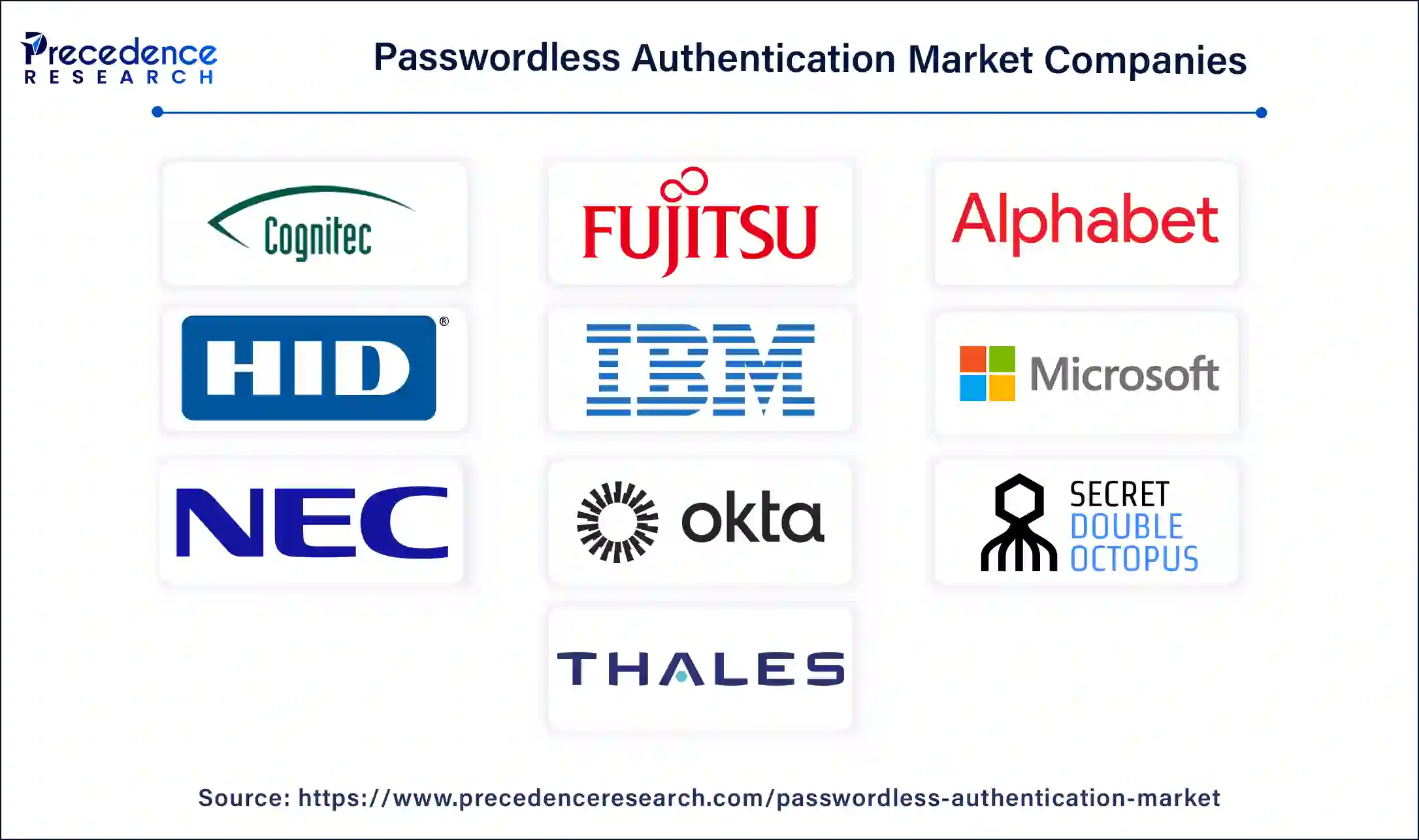
- Cognitec Systems GmbH
- Fujitsu Limited
- Google LLC (Alphabet)
- HID Global Corporation
- IBM Corporation
- Microsoft Corporation
- NEC CORPORATION
- Okta
- Secret Double Octopus (SDO)
- Thales Group
Latest Announcements by Industry Leaders
- April 30, 2024 – Hawcx
- Co-founder & CTO - Selva Kumaraswamy
- Announcement- -Hawcx, a leader in intelligent passwordless authentication, has made a significant leap forward with the launch of its innovative platform. This platform aims to transform the authentication experience for enterprises and end-users alike, offering a seamless combination of security and convenience. Selva Kumaraswamy, Co-Founder and CTO of Hawcx expressed excitement about the platform's impact, stating, "Innovative key-based authentication secures sensitive user data, ensuring peace of mind for enterprises and end-users." He further emphasized that the platform is designed to be platform-agnostic, democratizing access for all internet users, thereby driving the adoption of secure authentication practices across diverse sectors. This milestone positions Hawcx as a key player in the passwordless authentication space, aiming to mitigate the security risks tied to traditional authentication methods.
Recent Developments
- In September 2024, Bitwarden, a trusted leader in password, secrets, and passkey management, announced key improvements to its inline autofill capabilities within the Bitwarden browser extension. Following the recent addition of autofill features for cards and identities, this update now supports passkey autofill, offering users a faster, more secure, and seamless login experience on websites and applications that support passkey authentication.
- In June 2024, REA launched a fully passwordless sign-in experience across its major brands, marking a significant step in improving user security and data protection. To celebrate, REA hosted a 10-day AI Art exhibition at its Cremorne headquarters in Melbourne.
- In March 2024, KSI Keyboards and AuthX partnered to enhance passwordless security in healthcare settings. Announced just ahead of the HIMSS24 conference in Orlando, this collaboration combines KSI's advanced keyboards featuring integrated RFID and fingerprint biometrics with AuthX's single sign-on (SSO) platform.
Segments Covered in the Report
By Component
- Hardware
- Security tokens (e.g., FIDO2 keys, USB tokens)
- Biometric sensors (fingerprint scanners, iris/retina scanners, facial recognition devices)
- Smart cards / NFC-enabled devices
- Wearables (e.g., smartwatches with authentication capabilities)
- Software/Platform
- Identity & Access Management (IAM) platforms
- Authentication APIs & SDKs
- Passwordless login platforms
- Mobile authentication apps
- Behavioral biometrics software
- Services
- Professional Services
- Implementation & Integration
- Consulting
- Security Assessments
- Managed Services
- Professional Services
By Authentication Type / Technology
- Biometric Authentication
- Fingerprint Recognition
- Facial Recognition
- Voice Recognition
- Iris/Retina Scan
- Palm/Vein Recognition
- Token-based Authentication
- Security Keys (e.g., YubiKey, Google Titan)
- Smart Cards
- Wearable Tokens
- SMS / Email-based OTPs (note: increasingly phased out due to lower security)
- Push Notification Authentication
- QR Code Authentication
- Magic Links (Email or App-based)
- Behavioral Biometrics
- Typing pattern
- Mouse movement
- Navigation habits
- Device-based Authentication
- Device fingerprinting
- Trusted device check
- Certificate-based Authentication (e.g., PKI)
By Authentication Channel
- Web-based
- Mobile App-based
- Desktop/Workstation-based
- Multi-channel (Omnichannel platforms)
By Deployment Mode
- On-premises
- Cloud-based
- Hybrid
By Enterprise Size
- Large Enterprises
- Small and Medium Enterprises (SMEs)
By Use Case / Application
- Workforce Authentication
- Employee access management
- Remote work authentication
- Consumer Authentication
- Online banking/fintech login
- E-commerce / online transactions
- Social media and content platforms
- Mobile app logins
- Transaction Authentication
- Financial transactions
- Healthcare access
- Government & e-voting access
- Privileged Access Management (PAM)
By End User / Industry Vertical
- Banking, Financial Services & Insurance (BFSI)
- Healthcare
- Government & Public Sector
- Retail & E-commerce
- IT & Telecom
- Media & Entertainment
- Education (EdTech platforms, Universities)
- Energy & Utilities
- Transportation & Logistics
- Manufacturing
- Defense & Homeland Security
By Geography
- North America
- Asia Pacific
- Europe
- Latin America
- Middle East and Africa
For inquiries regarding discounts, bulk purchases, or customization requests, please contact us at sales@precedenceresearch.com
Frequently Asked Questions
Ask For Sample
No cookie-cutter, only authentic analysis – take the 1st step to become a Precedence Research client